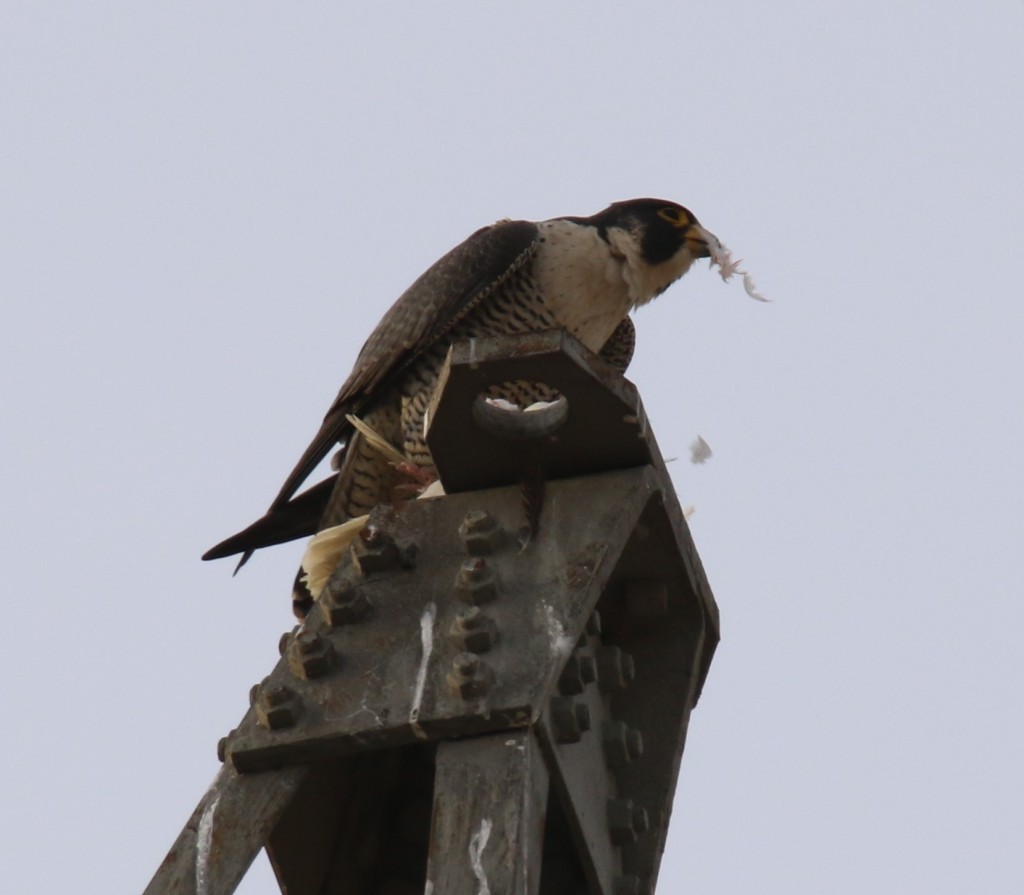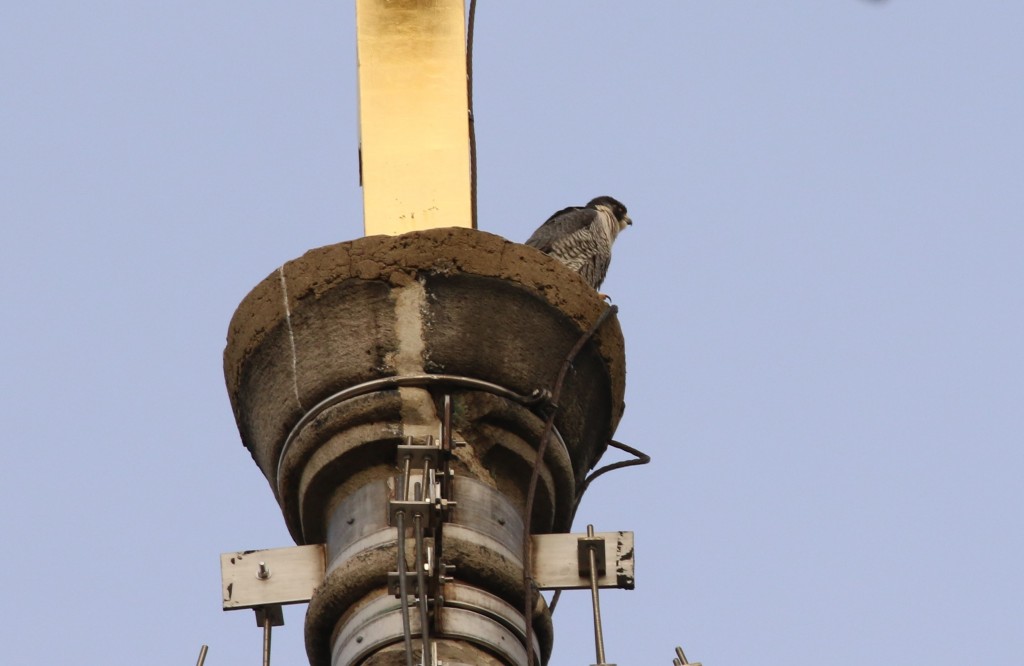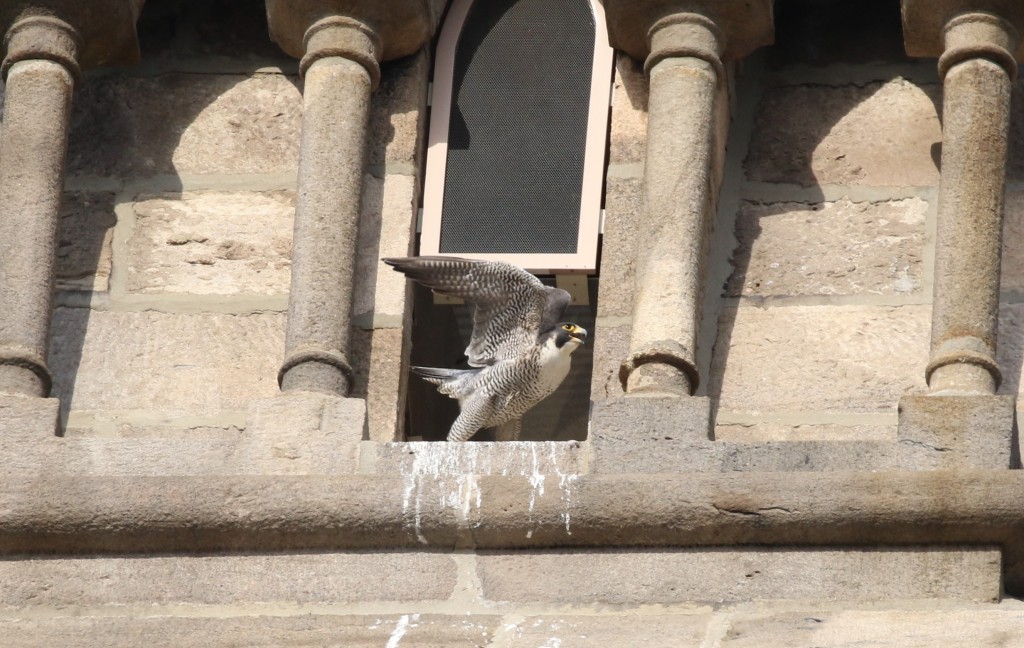
Here’s a good news story for these COVID-consumed times.
For Philadelphia’s birding community, spring means many things, especially the return of migrating birds to famous haunts like Carpenters Woods in Mt. Airy. To Roxborough’s Judy Stepenaskie, spring means the return of a pair of peregrine falcons – famously the world’s fastest animal – to the nesting box tucked into the top of the steeple of St. John the Baptist Church, the tallest stone spire in Manayunk’s skyline.
As Judy has become the de facto adopted godmother of the peregrines that nest there, following them assiduously, photographing them, sharing their story with fellow birders, this year’s edition of the peregrine story would prove especially poignant. The pair residing in the steeple had been together since 2011, Judy christening the male “Manny” and the female “Yunk.” Last fall, as I shared in this column, Judy was stunned to learn that Manny was found dead, its leg cleanly severed, possibly in mid-flight. Judy suspected a drone she had seen buzzing the steeple, its owner likely only wanting to film a flyover around Manayunk. But Manny perhaps assumed the drone was another large bird, and being territorial, dove for the drone – and got its leg sliced off, the bird falling to the ground and perishing. This is only a theory, but it sadly reads as logical.
So would Yunk find a new mate? Surprisingly, Judy didn’t have to wait long.

“In December last year,” Judy told me, “the female was out on the nest box’s ledge every day for most of the day – I guess she was advertising her site.” On Christmas Eve last year, she continued, “I saw a male on the steeple, perched on one of the finials. On Dec. 25, they were sitting at the steeple together.” Such a great Christmas present!
“Both peregrines stayed around during the winter,” she offered. “And I did see them mate once,” she confided, “on one of the electrical towers over the train tracks. They mate multiple times.”
In mid-March, she knew from their behavior that they had laid eggs. Success!
“I saw them do a nest exchange,” she noted, “where the female comes out of the nest box and the male goes in,” taking his turn incubating the eggs, a process that takes a full month or so. “She was out for about an hour and a half, preening herself, as her feathers were all fluffed up.”
Also in mid-March another new male came by, checking out the site and possibly sizing up the male as a competitor.
“He perched on the steeple for quite a while, watching. The female came out and chased it off, and the male went up to the nest box.” The male cleverly let the much larger female – that’s one way Judy can tell the two apart, the female is significantly larger – handle the territorial chores. Our female stayed loyal to her suitor.
She recounted a similar 2015 story from Baltimore where one of the males raised in this nest – one of Manny’s boys – challenged an older male peregrine on a nest box that already had eggs in it.
“He successfully chased off the existing one in Baltimore,” Judy said, “so the female simply pushed the existing eggs off to the side, mated with the new male, and laid a new set of eggs.” They do mate for life, but it seems they are not sentimental.
That didn’t happen here – the newer male was chased off, and presumably is looking for opportunities elsewhere.
Sometime in mid-April, Judy thinks between the 16th and the 21st, the eggs will hatch.
“That’s when I’ll see the female come out on the ledge – she’ll be out a lot, and she’ll sit at the nest box opening while looking back.”
It is a bittersweet ending to the story.
“I’m sad,” Judy volunteered, “because I miss the old male. I’m not sure how the new one is going to perform as a dad, and the old one was great.” Manny did father almost 30 new peregrines over his nine-year reign, including the Baltimore one.
Has she named the new one?
“I was thinking of MM2, short for Manayunk Male 2.” And she has already renamed Yunk, as there is no Manny as her companion anymore. Its new name? “I call her Liz,” Judy said, “as in Elizabeth, because she was hatched from a nest up in Elizabeth, New Jersey.”
While the names Liz and MM2 don’t have quite the cache of Manny and Yunk, it’s great to have a pair of peregrines back atop the steeple at St. John’s, producing more of these extraordinary but still-endangered birds.
Continued thanks to Judy for serving as the loyal falcon godmother, and thanks to the church for so graciously hosting them all these years.
Written by Mike Weilbacher, Executive Director

